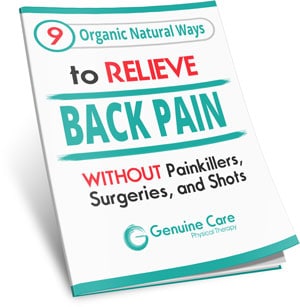
Unfortunately, people like you who suffer from low back pain experience a roller coaster ride of emotions. For the first few days, you are hopeful. You feel the pain radiating in your back but hope that, one morning, it will magically disappear. When it doesn’t, you start to search online. We call this “consulting Dr. Google”. The problem starts right here. I get numerous phone calls asking panicked, nonsensical questions like, “I have back pain. Is it because of cancer?”. They have searched online and found that low back pain can be a symptom of cancer. I tested it out and found that, if you search online for back pain, the number one search result says that low back pain is a symptom of cancer. In my twenty years as a physical therapist, I have never once seen a patient with low back pain because of cancer. Probably less than one percent of back pain patients have cancer as the root cause. But Dr. Google’s scary suggestion convinces you that you might have something seriously wrong with you. You become desperate to do something, try anything, to make the pain go away: take pain medicine, buy some patches, try steroid injections, or consider surgery. But despite your best efforts, your pain goes up and down, and you begin to feel discouraged and stressed, wondering if Dr. Google was right: that something is seriously wrong with you.
Your doctor is reluctant to order an MRI and prefers to prescribe you pain medication, but it makes you feel sick and sleepy, and doesn’t even help that much. The pain keeps getting worse and worse and, now, you are considering even more options than you were before. Your friends suggest chiropractic care, acupuncture, inversion tables, new, different braces, massage therapy, among other things. You head back to your doctor’s office and ask for something different, hoping that either you will finally get that MRI to put your fears to rest or your doctor will dole out some miraculous cure that can fix your ridiculously persistent back pain.
Instead, you are offered stronger pain medication or a steroid shot. You start to worry even more. You wonder if you’ll have to have surgery. You worry that you won’t be able to work, play the sports you love, spend time with your family. You worry you will be stuck at home, suffering and alone. You feel stuck, spending money on ineffectual solutions. You wonder if there is any hope at all.
"I’m here to say there is....
...You’ve Been Lied To"
You read above about the emotional roller coaster ride of those with low back pain.
We covered the terrifying suggestions fed to you through the internet and the ineffectual solutions presented. And now, you need to know who’s behind that wrong information.
I’m sure you won’t be surprised to learn that it’s the drug companies selling pharmaceuticals and the large medical centers profiting from imaging and surgeries, among other businesses, who are pushing this information. They don’t have your best interests at heart, but are trying to scare you into action, hoping that you will choose one of the options they have presented to you. Dr Tim Flynn, a renowned back pain expert, asserts that, “The modern U.S. medical industrial complex has created, promoted, and sustained an epidemic in back pain.”
There’s a lot of BS because there is a lot of money backing that BS.
People in the U.S alone spend $90 billion dollars annually on the management of low back pain. This amount is 10 times more than the initial funding approved by Congress for the Coronavirus response. 10 times more. Where money and power exist, there is corruption. Unfortunately, this misinformation created by rich, powerful companies affects human quality of life–your quality of life–and even length of life.
The biggest BS has been created by the pharmaceutical industry. They suggest that your pain can be solved by their pain medications, that the side effects are minimal, and the consequences nil. I have been a physical therapist for 20 years and was the director of a hospital rehabilitation center for 3 years. I watched how the pharmaceutical industry successfully lobbied Congress to change the rules so that medical professionals could sell more drugs. They didn’t have the patient’s best interests at heart. No, they cared about the profit margin, and that’s it.
The result of this money-grubbing endeavor is an opioid epidemic. One in 3 patients who is over 65 receives an opioid prescription and one in 4 of them become long term abusers. 128 people die per day due to an opioid overdose. These people’s lives have ended because a pharmaceutical company decided that it was profitable to prescribe addictive drugs to mask patients’ pain.
There are now 3 times more steroid injections, 4 times more prescriptions for MRIs, 3 times more spinal fusion surgeries than there ever was before. There are young people fighting for their life in the ICU because they overdosed on opioids. There are policemen fielding calls for opioid related psychiatric problems, leaving them unable to respond to other calls that are crime related.
The medical industry has created this crisis, all in order to make more money.
My outrage at this situation prompted me to quit my high paying job as a director and open my own physical therapy practice. I chose to speak out against the healthcare system that exploits back pain for its own financial gain. My passion is to help you make the best decision for your health and provide the most effective and harmless solution for you. I am not interested in helping the healthcare system profit from your pain; I want to help you.
There is Hope for Your Aching Back
I know that, when you have back pain, you desperately want to know how to get rid of it and how long that process will take. When you don’t see any progress, you feel frustrated and hopeless, sick of being in pain. As I mentioned before, the medical profession, Dr. Google, and friends and family all offer strategies and solutions, but you just end up feeling more confused. One of the most common suggestions is the advice to get an MRI taken to see what’s going on. People ask me all the time: “Should I get an MRI?” And, honestly, the answer is, probably not, but I’ll get more into that later. Maybe you have already gotten an MRI done and you are having a hard time deciphering the medical jargon on your report. Words and phrases like ‘disc herniation’, ‘grade II spondylolisthesis’, ‘bone spur’, ‘disc protrusion’, ‘narrowing of the disc space’, ‘stenosis’, and ‘DJD’ all make your head spin. You have no idea what they mean but guess that they can’t mean anything good: your body must be seriously messed up.
I have good news for you. You aren’t messed up and broken beyond repair. In most cases, all of those scary words mean nothing. I say that they mean nothing because most people with all of these spinal issues don’t have any back pain at all! Popular ideas about back pain indicate that these conditions are responsible for your pain and must be fixed through pain killers and surgery, but this couldn’t be further from the truth.
The first research telling the truth about back pain was published in 1990…. That was 30 years ago! The study involved 63 volunteers who had no back pain whatsoever. As part of a medical study, they all had MRI’s taken. These showed remarkably concerning spinal issues, including discs herniating up to 36 percent, discs bulging up to 60 percent, and degenerative disc issues in 93% of the studies’ participants who were over 60 years old. In all instances, the patients felt no pain. The results of this study led to articles recognizing the possibility of patients wrongly choosing back surgery, convinced that the issues revealed in an MRI are the cause of their difficulties when another issue is actually at the root of their pain. In the years since the study, referrals for MRI’s have quadrupled and spinal fusion surgeries have tripled. More people than ever end up on long-term disability, suffering depression and surgical complications. The number one reason why people take opioids is chronic back pain, and 128 people die every day due to an opioid overdose. Surgery didn’t fix these patients’ pain, and the interpretation of the MRI’s they received wrongly pushed them in that direction.
When a patient gets an MRI taken first instead of beginning with physical therapy, they are 6 times more likely to get surgery. In reality, only about 2% of patients with back pain require surgery, while physical therapy is proven to actually help. In order to truly ascertain if a patient requires surgery, it is necessary for the doctor to thoroughly examine you, spending enough time to know your symptoms and history, check your motions, sensations, reflexes, and levels of strength, and watch you sit, walk, and move. Your clinical presentation must match the results of the MRI in order for surgery to be warranted. Many surgeons simply recommend surgery based on MRI results. If this has been the case with you, please get a second opinion before deciding to move forward with the surgery.
There are very few patients who actually need MRI’s or X-ray images: those who are suspected to have suffered a spinal fracture, those who have a history of cancer and present with other cancer symptoms, and those are suspected of having Cauda Equina Syndrome.
To elaborate, if someone has been involved in recent trauma, are osteoporotic and have fallen, or are a long term steroid user who has fallen, and then present with back pain, an MRI or X-ray is needed to rule out a fracture.
In order for cancer to be the suspected cause of back pain, and an MRI or X-ray to be needed, a patient needs to have a history of cancer along with other cancer symptoms, such as unexpected weight fluctuation and unusual fatigue and tiredness. Back pain is rarely indicative of cancer. In fact, only 0.6% of back pain cases are caused by cancer.
Finally, an MRI might be needed if Cauda Equina Syndrome is suspected. However, this condition is high specific and also includes unique symptoms. The syndrome involves damage to the nerves at the end of a person’s spinal cord. Key symptoms include changing sensation in the private area along with urinary and bowel issues.
Obviously, these three different situations that warrant imaging are extremely specific and do not fit most cases on back pain. A physical therapist will screen for all of these issues and, given the high probability that these problems are not the cause for your back pain, will be able to begin a treatment plan with you that could actually help you fix your back pain.
I urge you to reconsider the suggestion to get an MRI and discourage you even more from jumping right into a surgery. Get a second opinion. Try physical therapy. I think you’ll be surprised at how much hope there is for you.
- Stop treating people like dead - March 25, 2024
- Stop Asking Me ‘Where are you from?” - March 25, 2024
- You Need the Right Diagnosis, not the Right Technique - November 25, 2020






